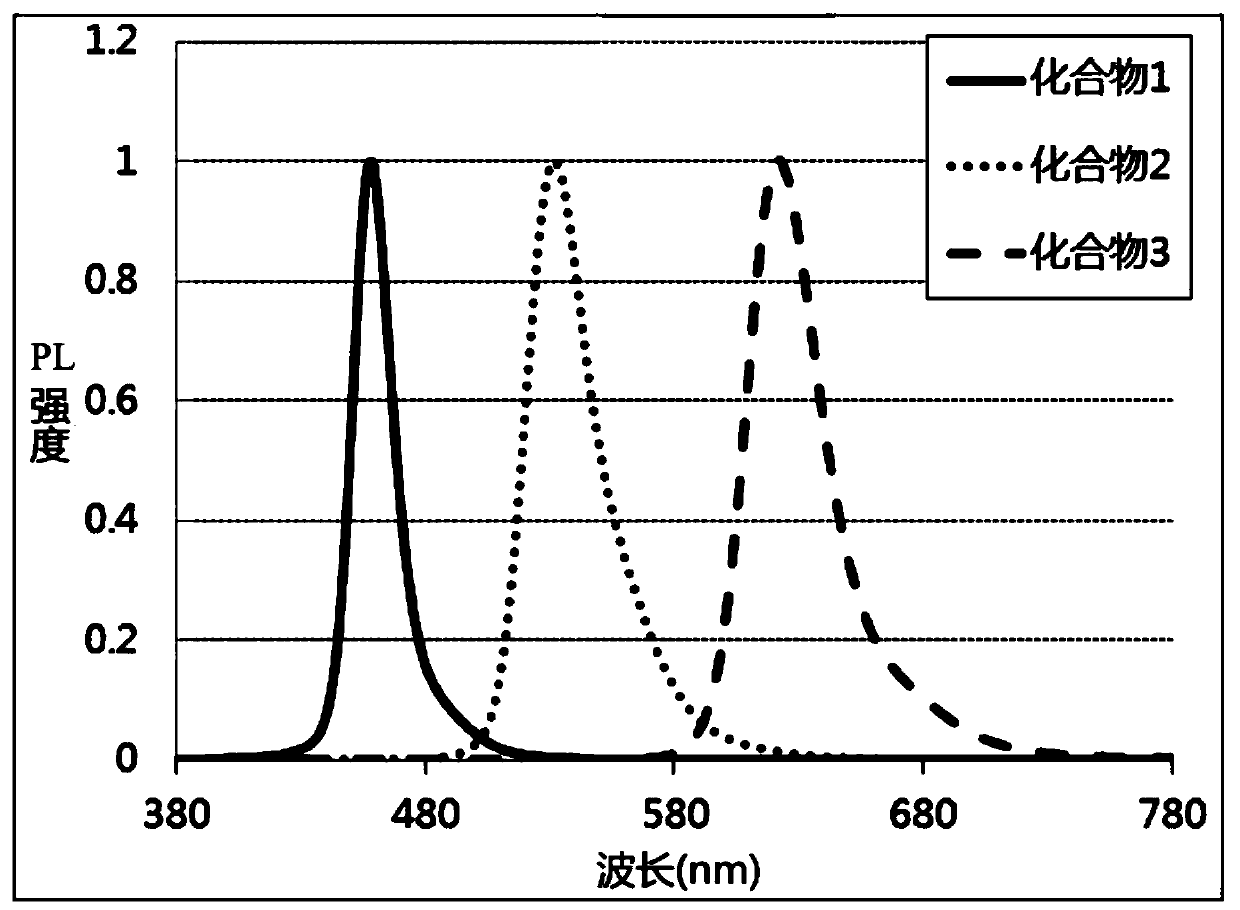Thermally activated delayed fluorescence material and organic light-emitting diode prepared by using same
A heat-activated delayed, light-emitting diode technology, applied in the direction of luminescent materials, organic chemistry, chemical instruments and methods, etc., can solve the problem of lack of heat-activated delayed fluorescent materials, and achieve low singlet triplet energy level difference, high luminous efficiency, high light Effect of Luminescent Quantum Yield
- Summary
- Abstract
- Description
- Claims
- Application Information
AI Technical Summary
Problems solved by technology
Method used
Image
Examples
Embodiment 1
[0027] Example 1: Preparation of thermally activated delayed fluorescent material with the following structural formula
[0028]
[0029] The synthesis steps are as follows:
[0030]
[0031] First, add raw material 1 (3.0g, 5mmol), carbazole (2.0g, 12mmol), palladium acetate (90mg, 0.4mmol) and tri-tert-butylphosphine tetrafluoroborate (0.34g, 1.2 mmol). Then, put the two-necked bottle into the glove box, and add NaOt-Bu (1.16 g, 12 mmol) into the two-necked bottle. Next, under an argon atmosphere, pour 100 mL of toluene that had been dehydrated and deoxygenated into the two-neck flask, and react at 120° C. for 48 hours to obtain a reaction liquid. After cooling to room temperature, the reaction solution in the two-neck flask was poured into 300 mL of ice water. Subsequently, the reaction solution was extracted with dichloromethane. After three extractions, the organic phases obtained from each extraction were combined and separated and purified by column chromatogra...
Embodiment 2
[0032] Example 2: Preparation of thermally activated delayed fluorescent material with the following structural formula
[0033]
[0034] The synthesis steps are as follows:
[0035]
[0036] First, add raw material 1 (3.0g, 5mmol), 9,9-dimethylacridine (2.5g, 12mmol), palladium acetate (90mg, 0.4mmol) and tri-tert-butylphosphine tetrafluoroethylene to a 250mL two-necked flask Borate (0.34 g, 1.2 mmol). Then, put the two-necked bottle into the glove box, and add NaOt-Bu (1.16 g, 12 mmol) into the two-necked bottle. Next, under an argon atmosphere, pour 100 mL of toluene that had been dehydrated and deoxygenated into the two-neck flask, and react at 120° C. for 48 hours to obtain a reaction liquid. After cooling to room temperature, the reaction solution in the two-neck flask was poured into 300 mL of ice water. Subsequently, the reaction solution was extracted with dichloromethane. After three extractions, the organic phases obtained from each extraction were combined...
Embodiment 3
[0037] Example 3: Preparation of thermally activated delayed fluorescent material with the following structural formula
[0038]
[0039] The synthesis steps are as follows:
[0040]
[0041] First, add raw material 1 (3.0g, 5mmol), phenoxazine (2.2g, 12mmol), palladium acetate (90mg, 0.4mmol) and tri-tert-butylphosphine tetrafluoroborate (0.34g , 1.2 mmol). Then, put the two-necked bottle into the glove box, and add NaOt-Bu (1.16g, 12mmol) into the two-necked bottle. Next, under an argon atmosphere, pour 100 mL of toluene that had been dehydrated and deoxygenated into the two-neck flask, and react at 120° C. for 48 hours to obtain a reaction liquid. After cooling to room temperature, the reaction solution in the two-neck flask was poured into 300 mL of ice water. Subsequently, the reaction solution was extracted with dichloromethane, extracted three times, and the organic phases obtained by each extraction were combined, and separated and purified by column chromatog...
PUM
 Login to View More
Login to View More Abstract
Description
Claims
Application Information
 Login to View More
Login to View More - R&D
- Intellectual Property
- Life Sciences
- Materials
- Tech Scout
- Unparalleled Data Quality
- Higher Quality Content
- 60% Fewer Hallucinations
Browse by: Latest US Patents, China's latest patents, Technical Efficacy Thesaurus, Application Domain, Technology Topic, Popular Technical Reports.
© 2025 PatSnap. All rights reserved.Legal|Privacy policy|Modern Slavery Act Transparency Statement|Sitemap|About US| Contact US: help@patsnap.com



